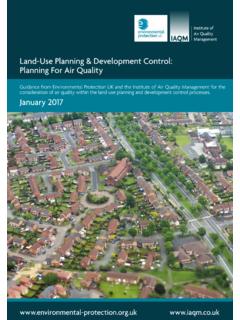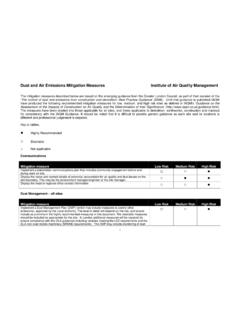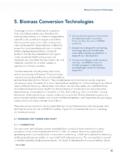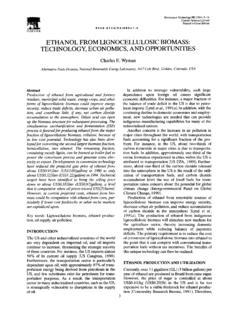Transcription of Biomass and Air Quality Guidance - IAQM
1 Biomass and Air Quality Guidance for Scottish Local Authorities About Environmental Protection UK. Environmental Protection UK's vision is of a cleaner, quieter, healthier world. We seek changes in policy and practice to minimise air, noise and land pollution, bringing together stakeholders to inform debate and influence decision making. We are a national membership based charity and have been playing a leading role in environmental protection in the UK since 1898. Contact Details: Environmental Protection UK - Scotland c/o Glasgow City Council 231 George Street,GLASGOW, G1 1RX. Tel 0141 287 6530. Fax 0141 287 6592. Email Registered Charity in Scotland: SCO40990. Registered Charity in England and Wales: 221026. Credits Original material for this Guidance document has been supplied by: AEA Technology London Borough of Camden Environmental Protection UK. Parts of this Guidance have drawn upon other documents, including material prepared by: The Carbon Trust Beacons Low Emission Strategy Group Environmental Protection UK.
2 Environmental Protection UK Scotland gratefully acknowledges the assistance provided by the steering group set up to oversee the development of this Guidance . Steering group member organisations included: AEA Technology BMT Cordah Dundee City Council Scottish Environment Protection Agency The Scottish Government The steering group was chaired by BMT Cordah. Funding for the development of this Guidance was provided by DEFRA under the Air Quality Grant Programme. Image on front page: Salvez Dodds Environmental Protection UK, June 2010. Contents . Executive Summary Chapter 1 Background Scope of this 1. Types of 1. Introduction to the Air Quality Impacts of Biomass 2. The Policy 3. The Policy Context (Air Quality ).. 6. Chapter 1 - Reading 7. Chapter 2 Boilers, Fuels, Standards and Certifications Biomass 9. Biomass (Wood) 10. Emission Standards and EN UK Emission 12. Other National 12. Ecolabelling and Other Emission 13. Chapter 2 - Reading 13. Chapter 3 Approvals and Consents Biomass in the Planning 15.
3 General Permitted 15. Section 75 15. Regulation of Biomass 16. Regulatory 16. Pollution Prevention and 16. Best Available 16. Waste Incineration 17. The Large Combustion Plant Directive (LCPD).. 17. The Clean Air 18. Smoke from 18. Emissions from Commercial 19. Approval of Chimney (Stack and Flue) 19. Powers to Request Monitoring and 19. Chapter 3 - Reading 20. 20. 20. Chapter 4 Assessing Potential Impacts Energy Statements and Basic Information about a Biomass 23. Material Considerations at 26. Technical Information to Obtain on a Biomass Boiler / CHP 26. Screening Assessment LAQM Technical Guidance 26. Dispersion Modelling and Stack Height 28. Chapter 4 - Reading 30. Contents Chapter 5 Assessing Cumulative Impacts Logging 31. Conducting Screening 31. Transboundary 31. Monitoring Uptake of Smaller (Single House) Biomass 31. Chapter 5 - Reading 32. Chapter 6 Mitigating Potential Impacts Abatement of Nitrogen 34. Abatement of Particulate 34. Automatic Heat Exchange 35. Abatement Efficiencies and 35.
4 Fan Assisted 35. Design 36. Mitigation Through Wider 36. Chapter 6 - Reading 36. Chapter 7 Anticipated Progress The Renewable Heat 37. Emissions 37. Maintenance 37. Research and 37. Chapter 7 - Reading 38. Appendix A Biomass Boiler Technologies Batch Fuelled 40. Continuously Fired 40. Pellet 41. Wood Log 41. Continuous Firing of 41. Factors Influencing Boiler 42. Combined Heat and 43. Appendix B Fuel Specification 44. An Overview of the Effects of Fuel Specification on Operational and Emissions 44. Biomass Fuel 44. Specific Characteristics of Wood 44. Standards for Biomass 44. 45. Appendix C Screening Models .. 54. Appendix D The Air Quality Standards for Scotland UK Objectives Not Included in 56. Downloadable Tools Biomass Unit Conversion and Screening Assessment Tool Template Boiler Information Request Form Template Boiler Information Log Executive Summary Executive Summary In common with other combustion appliances, emissions from Biomass boilers and Biomass combined heat and power systems should be managed to ensure potential air Quality impacts are controlled.
5 Management of combustion appliances can include product and fuel standards, emissions abatement equipment, regulatory controls and / or planning controls to restrict where certain appliances can be installed. This Guidance aims to help local authorities understand and manage emissions from Biomass combustion, with a focus on the most common Biomass fuel wood. Biomass fuels are currently being encouraged to help Scotland meet ambitious targets under the Climate Change (Scotland) Act and the related Renewables Action Plan. Unabated climate change presents a major environmental and health hazard to the whole world, and de-carbonising our energy supply is therefore a priority. At the same time the UK is currently failing to meet legally binding EU air Quality standards in many areas, including parts of Scotland, and public health is suffering as a result. Management of Biomass combustion should therefore seek to encourage Biomass use, whilst limiting any negative effect on, or indeed improving, air Quality .
6 As a general rule of thumb Biomass boilers fuelled by clean, new wood have lower pollutant emissions than coal, roughly equivalent emissions to oil, but higher emissions than equivalent gas fired boilers. The process of assessment should therefore follow a risk-based approach based upon: The location of the boiler, could it affect areas of poor air Quality ? Is it in a densely populated area? Whether the Biomass plant is substituting for a boiler using a different fuel; if it's substituting for oil or coal, emissions might actually drop, but if it is replacing a gas fired system they are likely to rise The likely emissions standard of the boiler The type, Quality and quantity of Biomass fuel used. The approach to assessment should therefore have a lighter touch where risk is low (for example in a rural area where air Quality is good, and coal and oil are the realistic alternative fuels), and more rigorous where risk is high (for example in or adjacent to an Air Quality Management Area).
7 The declared view of the Scottish Government is that the air Quality impacts of a major expansion in Biomass heat can be controlled through the use of high Quality , low emission plant and targeting rural areas off the gas grid where coal and oil fired plant are currently used. In urban areas, or where an Air Quality Management Area has been declared, they would expect Biomass heat deployment to be less common, and larger (and therefore cleaner) Biomass units to be more prevalent. This Guidance document contains information on the policy background to Biomass , climate change and air Quality , details of the technology used in Biomass plant and their regulation, and finally advice on the management and mitigation of Biomass emissions. Several tools have been developed alongside this Guidance to help local authorities and their partners manage emissions. These are listed on the contents page, and are also available for download from This Guidance does not intend to be a complete guide to Biomass , and suggested reading links have been placed in the text if more detailed information is needed about any of the policies, technologies and methodologies raised.
8 This Guidance is intended as a companion to the more general Environmental Protection UK planning Guidance Development Control Planning for Air Quality ' which was updated in April 2010. Environmental Protection UK will be launching Air Quality and Climate Change' integrated Guidance towards the end of 2010. Biomass and Air Quality Guidance Background Chapter 1 - Background report Biomass Carbon Sink or Carbon Sinner?' can provide further information on Biomass burning is perhaps the oldest this subject (see Chapter 1 reading links). method of providing heating and hot water. Biomass does have other environmental In recent years pressure to reduce our and sustainability impacts associated with its reliance on fossil fuels such as coal, oil and use. These are mentioned in this Guidance gas has encouraged a large expansion in and links are given to sources of further the use of Biomass heat. Concerns have information. Dry, woody fuels are most been raised that this may have an adverse commonly burnt in a boiler to produce heat effect on air Quality and public health, for space heating and / or hot water or in particularly in densely populated urban a Combined Heat and Power (CHP) unit areas.
9 To produce both heat and electricity. This Biomass can have a variety of meanings, Guidance uses the term Biomass boilers' to but in the context of this Guidance it refers cover both boilers and CHP units. to deriving energy from biological material The burning of waste wood may be subject through a transformation process. The to more stringent environmental regulation energy provided may be heat, electricity or than the burning of clean, new wood. These mechanical power. The biological material issues are examined in Chapter 3. may come from animal or plant sources At the time of writing this document, (including animal wastes and composts), technology and legislation surrounding whilst the transformative process may the air Quality effects of Biomass be direct combustion or perhaps involve were developing quickly. Updates to gasification, fermentation or pyrolysis. this Guidance will be posted at www. The status of Biomass as a renewable low carbon fuel means there is growing and we strongly recommend checking for interest in using it to help meet local and updates when using this Guidance .
10 National targets for renewable energy. Where Biomass plants occur as part of a As a relatively mature renewable energy larger development there will be a need to technology, Biomass can be one of the meet regulatory (pollution) conditions and most cost effective and therefore attractive also gain planning approval. Both issues technologies to use. are looked at in Chapter 3 of this Guidance . Wider air Quality issues surrounding Scope of this Guidance development control are considered in the This Guidance covers the burning of dry Guidance document Development Control: and seasoned woody fuels only as this is Planning for Air Quality ' which is available to the most popular form of Biomass deployed download from the Environmental Protection in the UK ( wood chips, pellets and UK website. logs with up to 50% moisture content). An information leaflet for developers has The document is aimed at Scottish local been produced alongside this Guidance authorities and is intended to help officers document.











